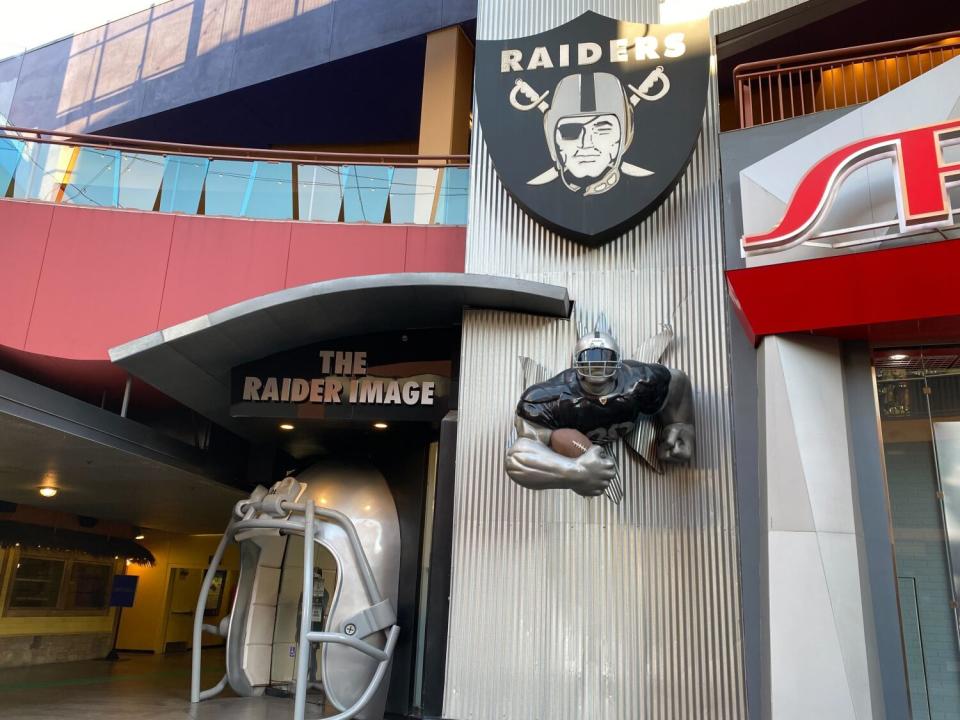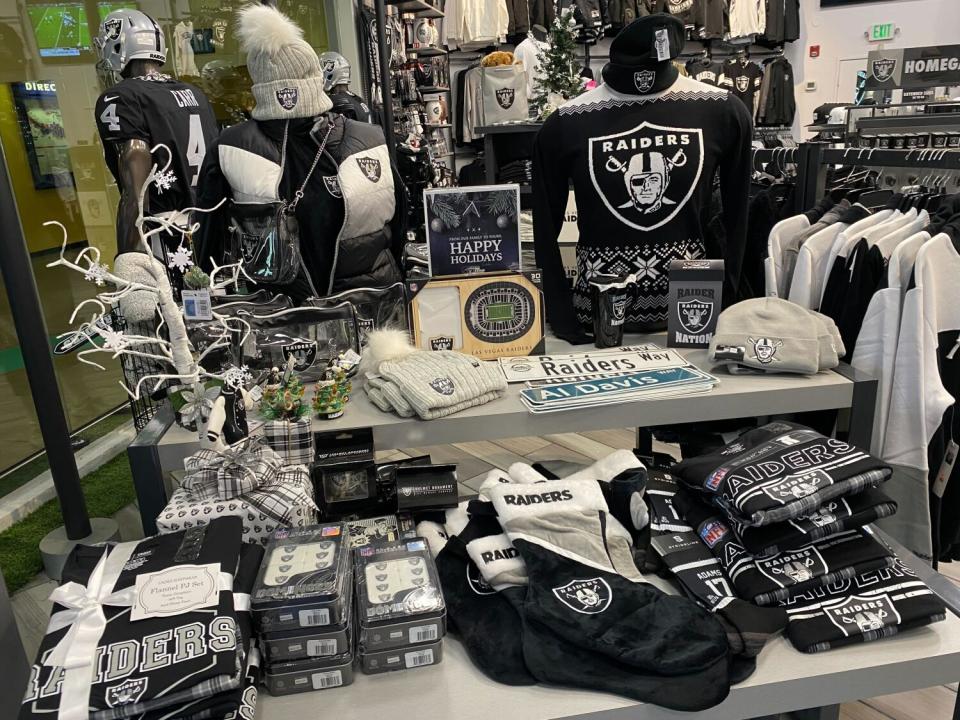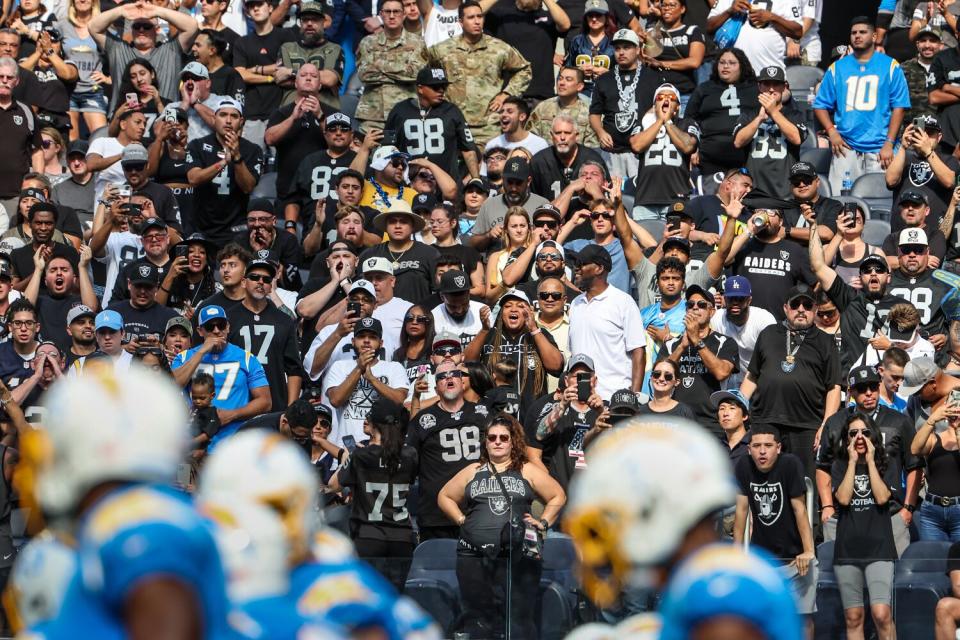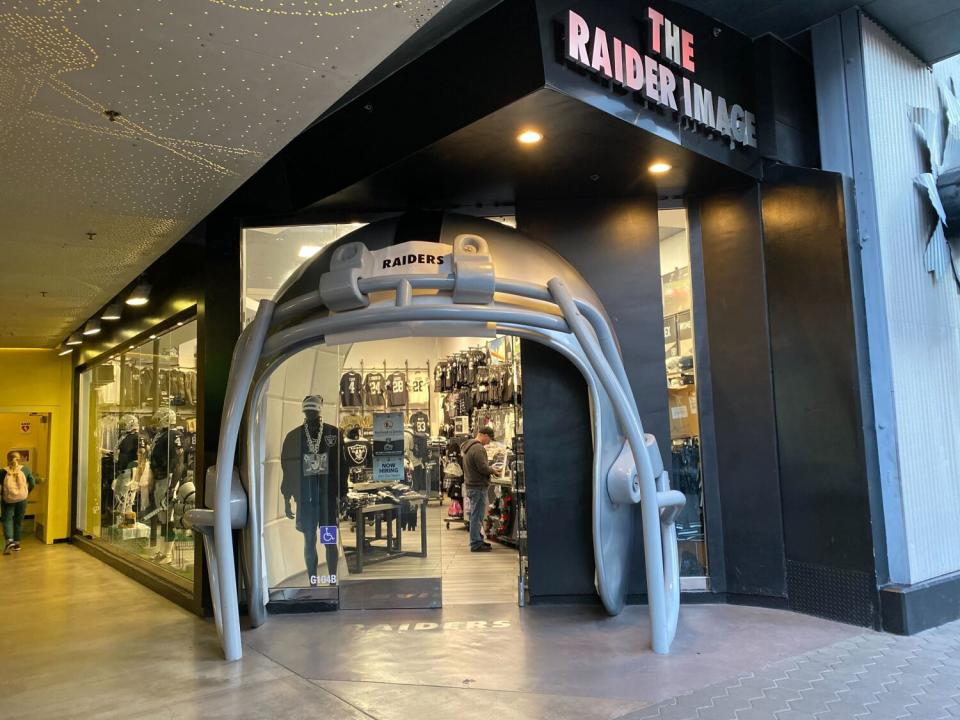The Raiders return to L.A. on Thursday night. In many ways it's as if they never left

The Raider Image, a store with a giant Raiders helmet for an entrance, was briefly without a customer Saturday afternoon. A young woman was behind the register. Otherwise, the modest space was empty amid the surrounding chaos at Universal CityWalk.
Not for long.
“We have some new things,” the employee told a family of four once they entered through the helmet tunnel. “Holiday items and blankets.”
Within minutes, the store was packed with people browsing through all things Raiders: Dominoes, stockings and sleep sets. Shot glasses, wine glasses, beer glasses and sunglasses. Baby clothes, jerseys and jackets. Raiderettes calendars. Black and Silver everywhere.


The Raiders haven’t called Los Angeles home since 1994. Art Shell was their coach. Jeff Hostetler was the quarterback. Derek Carr was 3 years old. They left for Oakland and then, in 2020, fled California altogether for Las Vegas.
The Rams were the other team in the area — though in Anaheim beginning in 1980, not Los Angeles — until leaving in 1994 for St. Louis and moving back to Los Angeles in 2016. The Chargers came north in 2017 and both moved into SoFi in 2020.
This week, the past and present collide over a five-day stretch.
On Sunday, the Raiders played host to the Chargers, beating them 27-20 at Allegiant Stadium in Las Vegas to keep their slim postseason hopes alive.
On Thursday, they’ll take the field at SoFi Stadium to play the Rams, whose precipitous downfall hasn’t drawn nearly as much attention as it would for a reigning Super Bowl champion in just about any other city and, well, doesn’t that tell you everything you need to know about their standing in Los Angeles?
All the while, the Raiders’ presence never abandoned the city. It remains emotionally through fans who rooted for the team at the Coliseum in the 1980s, were part of the craze in the early 1990s when N.W.A. made the Raiders brand national, and passed along the obsession to their children. It remains physically, through the logo and colors still synonymous with pockets of L.A., and the brick-and-mortar retail establishment 20 miles from SoFi Stadium.
“The Raiders still own this town,” Eddie Parra, a Raiders fan, said while shopping Saturday.
Parra, 46, grew up in Wilmington, by the Port of Los Angeles, and still lives there. He went to Raiders games at the Coliseum with his uncles as a kid. When the team left, he attended three or four games a season in Oakland for 22 consecutive years. He now travels to Las Vegas for a game every season and goes to SoFi Stadium every time the Raiders play there.
He’ll be in the crowd with friends Thursday. He expects a bigger turnout from Rams fans than he saw when the Chargers beat the Raiders in Los Angeles in Week 1.

“The Rams already had their fan base,” Parra said. “They had a built-in fan base. But the Chargers, I don’t think they’re going to make it here, bro. They’re going to end up going back [to San Diego].”
The Raiders moved to Las Vegas with about 15% of their season-ticket holders living in Southern California. Johnny Cervantes and his wife, Letty, are two of them.
Cervantes’ fandom began in the 1980s growing up in Boyle Heights. He said he’d buy tickets for $10 outside the Coliseum after kickoff in the Raiders’ final years in Los Angeles.
The couple attended its first game in Oakland in December 2001 and “got hooked.” They began attending multiple games per season in 2002 and became season-ticket holders in 2008, driving up to Oakland from Maywood to watch the Raiders play as much as possible.
When the team moved to Las Vegas, they followed. Fans weren’t permitted at Allegiant Stadium because of COVID-19 during the 2020 season, but they went to Las Vegas anyway and watched the games from the casinos.
“It felt like we were at the game,” Cervantes, 53, said.
Last season, they went to every Raiders home game — preseason and regular season. This year, they’ve missed just one game — the Raiders’ Week 7 win over the Houston Texans. They won’t be at Thursday’s game in Los Angeles, but plan to attend the Raiders’ remaining three home games.
Raiders will be well represented Thursday.
Vivid Seats, a ticket marketplace, projected that the Raiders enjoyed a 74% to 26% crowd advantage when the Raiders faced the Chargers in Los Angeles last season, according to content manager Stephen Spiewak.
The company projects 63% of Thursday’s crowd at SoFi Stadium will side with the Raiders over the Rams. And most of those people won’t travel from Nevada.
“The overwhelming majority of orders are from fans in California,” Spiewak said in an email.
Tony Ioele plans to be among the Raiders fans Thursday. He’s been a Raiders fan since he was 6 years old, growing up in San Gabriel watching them win their last Super Bowl in 1984 with Marcus Allen at running back. He prefers to watch Raiders games alone — “I get too obsessed” — but he’ll make an exception Thursday and attend the matchup against the Rams. He expects Raiders fans to outnumber their counterparts.
“Raiders fans are a different breed,” Ioele said.
Paul Vega was raised in El Sereno and attended Raiders games in the 1980s. They were, he believes, the closest thing to a Mexican soccer game in the United States. People wore intricate gear. They threw bombs of beer when touchdowns were scored. It was a cultural experience. When Los Angeles became an NFL desert, he shifted to USC for his local football appetite while occasionally heading north for games in Oakland.
Others assumed the same allegiances while others became fans of other NFL franchises. He said he’s “definitely” seen more Rams fans since they returned to the area.
“I had Rams season tickets the first year they were at the Coliseum and it was a little more fan friendly than a Raider game,” Vega said with a laugh. “I say it jokingly because if you’ve never had the Raider experience, there’s nothing like it. It’s crazy.”

The Raider Image has several locations in Nevada and three in California. The other two are in Bakersfield and in Moreno Valley. Neither attracts the foot traffic at Universal.
The employee working Saturday, who declined to share her name, said the store is busiest during “full deck” days — the day before, day of, and day after the Raiders play a game in Los Angeles. She said the store pulls employees from the Moreno Valley location to deal with the surge. She expected this week, with the Raiders in town, to be no different.
They’ll have the game on the television Thursday. People looking to spend will surface. “A vibe,” the employee said, will be created. It becomes an impromptu watch party.
“You kind of have to like the Raiders,” she said. “But we don’t discriminate.”
Evidence: A man in a Rams cap browsed through the store unimpeded Saturday surrounded by Raiders die-hards. One woman lamented that it wasn’t the same since the Raiders left Los Angeles. A man shopped with his teenage son. Another woman asked about baby clothes. The customers ranged from young to old.
The Rams fan shopping wore a T-shirt with “El Jefe” on the front. He wasn’t the boss in there.
This story originally appeared in Los Angeles Times.

 Yahoo Sports
Yahoo Sports 